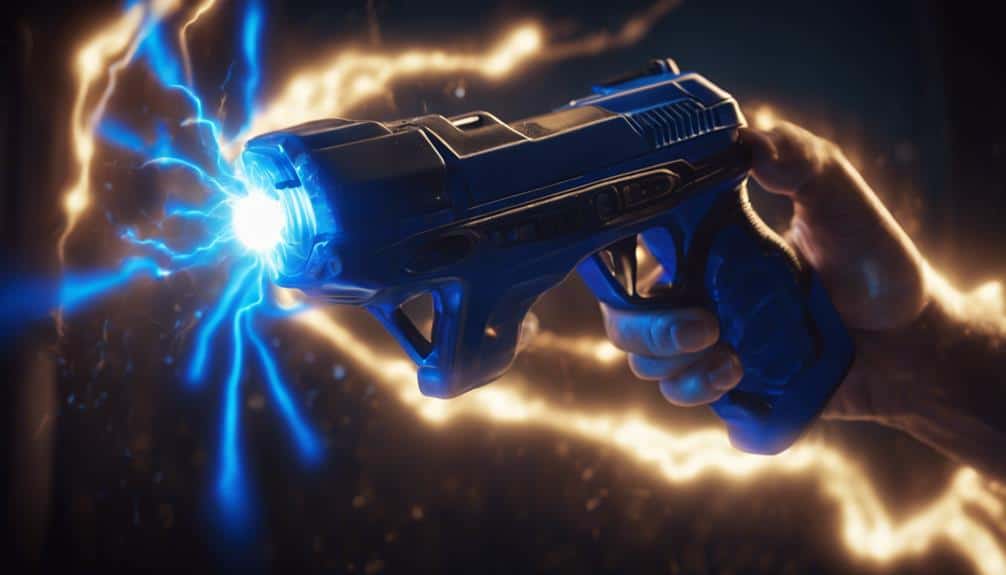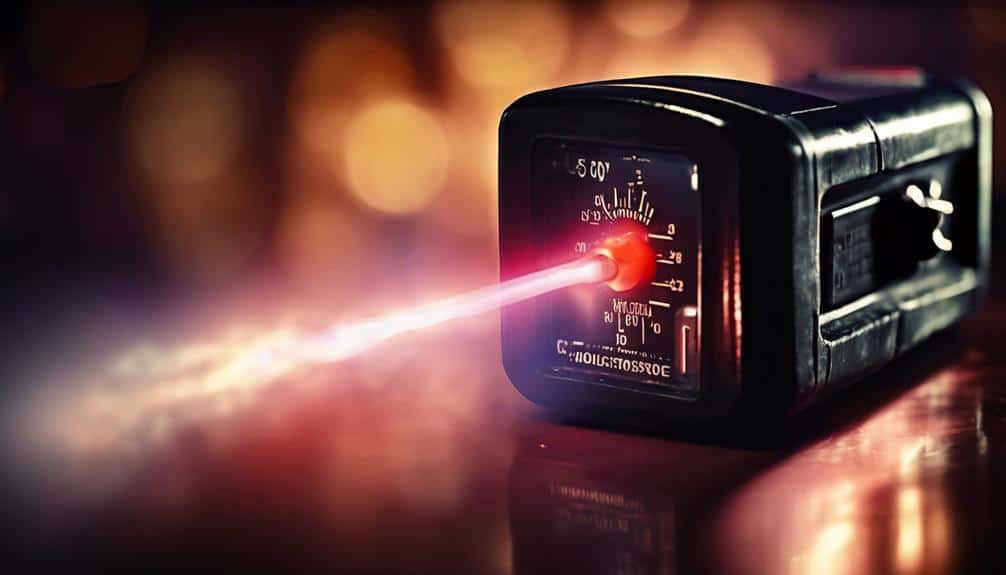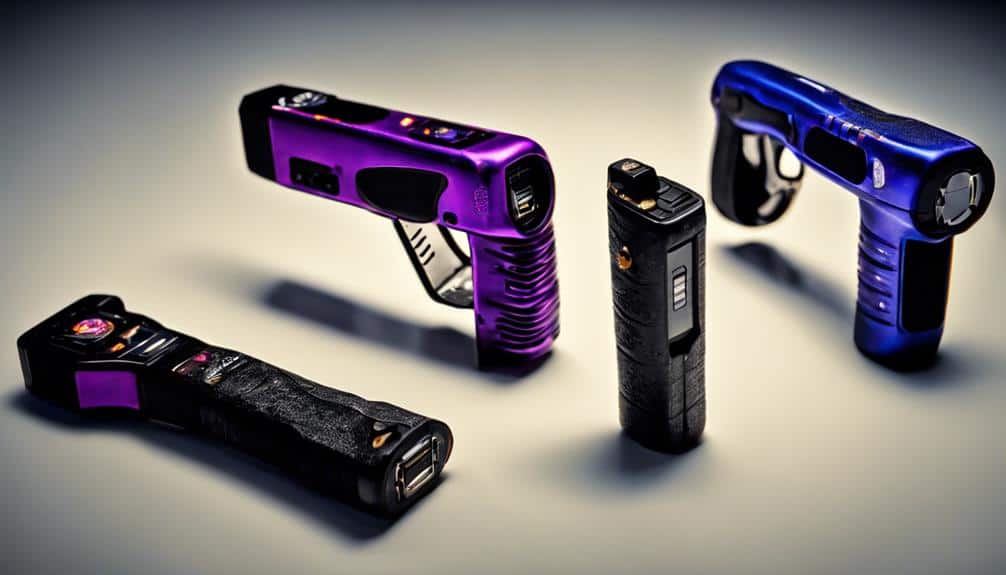You’re probably wondering just how much zap is legally allowed in a
stun gun, right? Well, imagine, in most places, a stun gun’s power can’t exceed
30,000 volts at a 1 cm distance. That’s enough to make anyone think twice before getting too close! But here’s the twist: states like New York and New Jersey keep things on a tighter leash with extra
regulations. And did you know that while higher volts sound impressive, it’s the
microcoulombs that pack the real punch? So, if you’re curious about staying on the right side of the law without losing the thrill, let’s unpack more!
Understanding Stun Gun Voltage
Understanding
stun gun voltage starts with knowing the basics of how
electricity interacts with air. Imagine this: electricity is like a stubborn squirrel trying to jump from one branch to another. The branches? Those are the stun gun contacts, and the air in between is the space the squirrel needs to leap across. The
maximum voltage a stun gun can achieve depends on this jump. For a 1 cm gap, it can reach 30,000 volts. The
legal regulations in your area might dictate what’s reasonable, so it’s like a squirrel’s jump being limited by the local tree-climbing laws! Many stun guns, like the
Fang Keychain Stun Gun, are designed for compact portability and high voltage output, making them effective
self-defense tools.
When choosing a stun gun for self-defense, you’ve got to think beyond just voltage. The
effective range can be between 25,000 volts and 100,000 volts, especially if you’re dealing with thick clothing. But what really matters is the
charge, measured in microcoulombs (µC). You wouldn’t want a tool that barely tickles, right? The
pain threshold is at 0.5 µC, but hitting 1.0 µC or more? That’s some serious ouch! Make sure your self-defense tool respects these pain levels and fits within the
legal limits of your state. It’s all about protecting yourself smartly!
Maximum Voltage Limits
So, you’re curious about
stun gun voltage, right? Let’s jump into the electrifying world of
maximum voltage limits, where you need to know that the voltage you see isn’t just a number—it’s calculated based on the distance between the contacts and legal restrictions. For example, the stun power of the
BashLite is an impressive 85,000,000 volts, showcasing how high voltage can provide enhanced protection. Imagine trying to zap a watermelon; if your contacts are spaced 1 cm apart, you’re hitting a limit of
30,000 volts, and going beyond that is like trying to argue with the
laws of physics—you’re not gonna win!
Voltage Calculation Method
When calculating the
maximum voltage limits for a stun gun, it is crucial to take into account the distance between the contacts. Imagine a tiny electrical field zipping through the air, its strength determined by the voltage—a hero in the world of stun gun strength! The
dielectric strength of air tells us that for
contacts spaced 1 cm apart, the max voltage is
30,000 volts. It’s like trying to jump over a puddle; the air can only handle so much before it breaks down. Reduce that distance to 0.5 cm, and you’re looking at 15,000 volts. Stretch it out to 2.0 cm, and voila, you get 60,000 volts!
Now, don’t get swept away with voltage alone.
Stun gun effectiveness isn’t just about the zap; it’s also about the shock, measured in
microcoulombs charge. A higher charge can lead to better incapacitation, kind of like the difference between a gentle nudge and a full-on surprise bear hug!
Legal Voltage Constraints
Maneuvering through the maze of legal voltage constraints for stun guns can be intimidating, but it’s essential for ensuring compliance with state regulations. Imagine you’re in a state where the maximum voltage for civilian stun guns is capped. You might think you can just crank up the voltage for extra oomph, but hold your horses! Legal regulations on maximum voltage aren’t just random numbers—they’re grounded in the physics of electricity.
For instance, at a spacing of 1 cm, the dielectric strength of air caps stun guns at 30,000 volts. Any claims exceeding this are just hot air! Here’s a handy table to help you visualize:
| Distance (cm) |
Maximum Voltage (V) |
Note |
| 0.5 |
15,000 |
Half a centimeter apart |
| 1.0 |
30,000 |
Standard spacing |
| 1.5 |
45,000 |
Increased spacing |
| 2.0 |
60,000 |
Max practical distance |
Now, don’t get zapped by the law! Voltage limits vary by state, so check local laws to make sure you’re in compliance. Remember, understanding these constraints isn’t just about following rules; it’s about ensuring safety and legality with your stun gun adventures.
Impact of Contact Distance
Understanding the impact of
contact distance on
maximum voltage limits is essential for anyone using a
stun gun. Imagine you’re holding a stun gun, ready to defend yourself, but if you don’t know the voltage limitations, you might as well be wielding a toaster. For instance, the
Repeller Stun Baton Black boasts an impressive
40,000,000 volts, providing significant defense capabilities. At a contact distance of 1 cm, the maximum voltage is 30,000 volts, dictated by the
dielectric strength of air. Move those contacts closer to 0.5 cm, and you’re looking at 15,000 volts. Increase the distance to 1.5 cm, and you could potentially zap up to 45,000 volts.
Now, if you’re wondering what happens at 2.0 cm, brace yourself—60,000 volts is the maximum voltage you can achieve. But here’s the kicker, if someone tries to sell you a stun gun claiming more than 30,000 volts at typical distances, they’re likely bending the laws of physics. Remember, the
dielectric breakdown of air sets these limits, so unless you’re in a vacuum, you’re not going to exceed them.
Solid contact with the assailant’s skin is vital. Without it, you might end up
shocking the air more than your target. So, keep those contacts close and let the
volts do the talking!
Voltage vs. Microcoulombs
Despite popular belief, the voltage of a
stun gun isn’t the sole determinant of its effectiveness; rather, the charge it delivers, measured in microcoulombs (μC), plays a pivotal role. You might picture a stun gun with a whopping 50,000 volts, thinking it’s the ultimate tool for self-defense. But here’s the twist: it’s the microcoulombs that really pack the punch. A mere 1.0 μC can induce unbearable pain and incapacitate someone in seconds. Additionally, many stun guns, like the FANG Keychain Model, come with an internal rechargeable battery that boosts their usability and effectiveness.
Here’s a quick rundown:
- Voltage vs. Microcoulombs: Voltage is like the flashy headline, while microcoulombs are the real story. They define the stun gun’s strength.
- Pain Thresholds: At just 0.5 μC, you start feeling pain. Push it to 1.0 μC, and you’re crossing into “no, thank you” territory.
- Incapacitation: This is the goal, right? High microcoulombs guarantee that your assailant won’t be staying for tea.
Factors Influencing Voltage
When you’re thinking about stun gun voltage, you’ve got to take into account the dielectric strength of air, which is like the ultimate referee, shouting, “Hold on, that’s too high!” if you try to push the voltage too far. It’s wild how this invisible force decides the maximum voltage based on the spacing between contacts—like a game of electric limbo, with 30,000 volts at 1 cm and 60,000 at 2 cm.
Additionally, the voltage of stun guns varies, with options like the Triad 27,000,000 Volts Stun Gun providing effective self-defense capabilities. Plus, you’ve got legal and safety rules coming into play, because let’s face it, nobody wants a stun gun that’s more like a lightning bolt in their pocket!
Dielectric Strength of Air
The dielectric strength of air, approximately 3 x 10^6 volts per meter (V/m), plays an important role in determining the maximum voltage that can exist without causing electrical breakdown. This might sound like sci-fi jargon, but it’s simple: air acts like a stubborn gatekeeper, only letting a certain amount of electricity pass before throwing a tantrum and breaking down. When you think about a stun gun, this energy gatekeeping is vital. You see, if the voltage across contacts spaced 1 centimeter apart exceeds 30,000 volts, you’re in for a shocking surprise—literally!
Here’s a quick rundown of why this matters:
- Dielectric Strength: It limits the maximum voltage that can pass through air without causing an electrical discharge.
- Contact Spacing: The wider the spacing, the more voltage can safely pass, but there’s a catch.
- Physical Laws: Violating these laws with exaggerated claims, like promising more than 30,000 volts at standard spacing, just doesn’t hold up.
Voltage and Contact Spacing
Understanding the
dielectric strength of air is just the beginning. Imagine this: you’re holding a
stun gun, and the
voltage it can deliver depends on something as simple as how far apart its contacts are. With
contact spacing at 1 cm, the maximum voltage you can expect is 30,000 volts, thanks to the dielectric strength of air. It’s like trying to squeeze through a narrow hallway; the closer the walls, the less room you’ve got to move. Many self-defense devices, like the
100 Million Volt Bouncer Stun Gun, offer impressive voltage outputs that can provide added safety.
Now, if you reduce the spacing to just 0.5 cm, the voltage drops to 15,000 volts. But stretch it out to 1.5 cm, and you’re ramping up the voltage to a whopping 45,000 volts. It’s a bit like having a superpower that grows stronger the more space you have!
Yet, the
laws of physics keep us grounded. Claims of stun guns with voltage beyond 30,000 volts across 1 cm contacts defy these laws. It’s crucial to grasp how voltage and contact spacing work hand-in-hand. This understanding helps guarantee stun guns remain
effective and safe, like a trusty sidekick in a superhero’s arsenal. So, when it comes to voltage, remember:
size matters!
Legal and Safety Considerations
Considering the intricate balance between legality and safety, knowing the voltage limits for stun guns in your area is essential. Stun gun state laws can be as complex as a soap opera plot and understanding them is key to staying on the right side of the law. You don’t want to be the person who thought they were prepared but ended up in hot water because of a technicality. The compact design of models like the
LiL Guy Pink Stun Gun makes them convenient for personal defense, but be sure to check your local laws regarding their use.
- Legal Voltage: The legal voltage for stun guns can vary by state. Some states set strict caps, while others are more lenient. A stun gun’s voltage typically maxes out at around 30,000 volts due to the dielectric strength of air, but effective incapacitation often requires higher voltages, sometimes 50,000 volts or more.
- Local Regulations: It’s not just about voltage; some places demand permits or ban stun guns that exceed certain thresholds. Knowing local regulations can save you a lot of headaches.
- Charge Delivery: This isn’t about your phone battery! Charge delivery, measured in microcoulombs, plays a significant role in a stun gun’s effectiveness. It’s a key factor that can influence both legal considerations and practical use.
Navigating these waters may seem intimidating, but a bit of research will keep you legally safe and effectively protected.
Legal Restrictions by State
When traversing the complex landscape of
stun gun laws, you’ll find that
legal restrictions vary widely from state to state. Some states let you use stun guns freely for
self-defense, while others have you jumping through hoops with
permits and paperwork. It’s a bit like trying to find the right voltage on a dimmer switch—sometimes it’s too high, sometimes too low, and sometimes just right. For instance, the legality of stun guns can depend on specific factors, including their effective self-defense features, which may influence how states classify them.
In places like
New York and New Jersey, the ownership of stun guns is wrapped up in a bundle of legal restrictions. These states treat them almost like ticking time bombs, buried deep within their
weapons laws. So, you better know what you’re getting into before you even think about buying one. Some states might not care much about the voltage, but they do care about how you use it. Self-defense? Sure, but misuse it, and you’ll find yourself in hot water faster than you can say “shocking!”
Before purchasing a stun gun, make sure to check your
local laws, or you might end up with a self-defense tool that’s more of a
legal liability. Be smart, stay informed, and zap wisely!
Safety and Usage Guidelines
When it comes to using a stun gun, you’ve got to be prepared and informed. This safety tool can be incredibly effective, but only if used correctly. For instance, a stun gun like the
100 Million Volt Bouncer can provide a considerable advantage with its high voltage and effective reach. Here’s what you need to know:
- Voltage and Effectiveness: The minimum effective voltage to inflict pain on an assailant is 25,000 volts, but to really pack a punch, especially through thick clothing, you want a stun gun with 50,000 to 100,000 volts. It should also deliver at least 1.0 microcoulombs for that “no way am I messing with you” level of incapacitation.
- Proper Contact: Make sure you have solid contact with the skin. Wider spacing between contacts can greatly improve the effectiveness of the voltage, delivering a more powerful shock. It’s like the difference between a gentle nudge and a firm handshake—aim for the latter.
- Know the Regulations: Stun gun laws can be trickier than a cat with a laser pointer. Regulations vary by state, so do your homework to verify you’re compliant. Some places have prohibitions or permit requirements, so don’t get caught off guard.
Lastly, always keep your stun gun charged and ready!
Comparing Stun Gun Models
Comparing
stun gun models requires understanding the balance between
voltage and the charge delivered, typically measured in
microcoulombs. Imagine this: you’re eyeing a powerful stun gun that claims 93,000,000 volts like the Jolt Tactical Police Rechargeable Stun Gun. Sounds impressive, right? But hold on, the real magic lies in the microcoulombs. For instance, the
Triad Pink Stun Gun delivers a high-voltage shock of 27,000,000 volts, making it a formidable option for
self-defense, especially considering its compact design and built-in rechargeable battery for convenience self-defense features. It’s like baking a cake; you need the right mix of ingredients, not just a blazing oven.
Let’s explore some models. Take the
SABRE 2-In-1 Stun Gun. It might not boast sky-high voltage, but at 2.762 microcoulombs, it packs quite a punch for incapacitation. And then there’s the TASER Pulse+. With 50,000 volts, it’s not just about voltage; its charge makes it a go-to for many self-defense enthusiasts. It’s like comparing fireworks to a laser show—different, yet effective.
When shopping, remember higher voltage doesn’t always mean better protection. It’s about finding that sweet spot where voltage and charge harmonize. So, next time you’re choosing, think like a chef, not just a firework enthusiast. Choose the stun gun that’s got the right recipe for your safety.
Alternatives to Stun Guns
Exploring alternatives to stun guns opens up a range of self-defense options that suit different needs and scenarios. If you’re thinking about personal safety, consider pepper spray. It’s like having a little can of justice in your pocket! It works from a distance, so you don’t have to worry about getting up close and personal with danger. Plus, it can leave an assailant crying—literally. But wait, there’s more!
- Personal Alarms: These gadgets are like having your own personal siren. Just pull the pin, and they’ll emit a loud noise that could make a rock concert seem quiet. It’s enough to scare off any potential attacker and draw attention to your situation.
- Self-Defense Keychains: Ever heard of kubotans? They’re small, discreet, and can pack a punch. Perfect for delivering a quick strike or helping you control an attacker’s movements.
- Tactical Flashlights: These aren’t your ordinary flashlights. They can temporarily blind an assailant, giving you a chance to escape without throwing a single punch.
Don’t forget emergency whistles, either! Lightweight, easy to carry, and perfect for signaling help when things get dicey.
Frequently Asked Questions
What Voltage Is a Police Taser?
Police TASERs deliver about 50,000 volts, ensuring taser effectiveness by disrupting muscle control. Voltage comparison highlights safety concerns, as legal definitions and device regulations aim to balance incapacitation with minimizing injury, especially for vulnerable populations.
What’s the Best Voltage for a Stun Gun?
When choosing a stun gun, focus on its effectiveness and safety. Voltage alone isn’t the best indicator. Consider regulations and personal defense needs. Compare using charge delivery methods instead. Prioritize reliable personal defense tools over misleading voltage claims.
You need to understand stun gun laws in your area before carrying one. They’re self-defense weapons, but legal regulations vary. Prioritize personal safety and electrical safety by ensuring you’re compliant with local rules on their possession and use.
Which Is Stronger, a Taser or a Stun Gun?
When you’re caught in the storm of self-defense tools, TASER effects can be more thunderous than stun gun usage. Though voltage safety is essential, TASERs often have stronger legal implications due to their range and incapacitation power.








